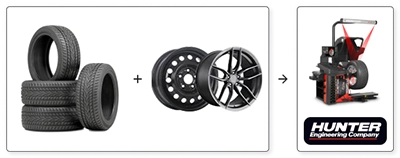Centre technique
Filtres
Voir plus
Articles

Comprendre les motifs de bande de roulement des pneus: comment monter, balancer et installer les différents types de pneus à la maison ou par un mécanicien
La saison hivernale approche à grands pas, et il est presque temps pour la plupart des Canadiens de passer de leurs pneus d'été ou toutes saisons aux pneus d'hiver. Comprendre les motifs de bande de r...

Comprendre les pneus cloutés: un guide complet de questions et réponses pour les conducteurs canadiens
Chaque hiver au Canada, les conducteurs à travers le pays sont confrontés au défi annuel de parcourir des routes qui peuvent rapidement se transformer en chemins verglacés et compliqués. Pour beaucoup...

Qu'est-ce que le DOT d'un pneu et quelle est notre politique sur ce sujet
Qu’est qu’un DOT et puis-je l’avoir avant l’expédition de mes pneus ? Le DOT est un code alphanumérique indiquant le fabricant, le pays, l’usine, ainsi que la semaine et l'année de production...

Configuration des boulons : Comment savoir si les roues sont compatible avec mon véhicule ?
Le modèle de boulon de votre véhicule est l'un des premiers critères, si ce n'est le premier, à prendre en compte pour déterminer si une roue s'adaptera ou non à votre voiture. Bien qu'il existe un gr...

Déport de roue
Le déport est la distance (en millimètres) entre le milieu de votre jante et la surface d'appui pour le montage. Sur une jante monobloc, le déport est fixe et ne peut être modifié. Sur une jante démon...

À quoi servent les anneaux de centrage ?
L'anneau de centrage est utilisé, comme son nom l'indique, pour être positionné au centre de la jante afin qu'elle puisse être installée et centrée correctement sur le moyeu. Les bagues de centrage so...

Évaluations de pneus
Des milliers d’évaluations réalisés depuis 2008 Nos évaluations de pneus sont effectuées dans le but de vous offrir une référence de qualité pour votre prochain achat, mais aussi d’ouvrir votre ho...

Pneus d'hiver, pourquoi ?
Pourquoi doit-on équiper nos véhicules de pneus spécifiquement conçus pour l’hiver ? Pour bien comprendre l’importance de ne pas conserver des pneus d’été ou d'un pneu 4 saisons durant la sai...

Pneu : Indice de charge et le nombre de plis
Les indices de charge L'indice de charge ainsi que le nombre de plis inscrits sur le flanc du pneu déterminent la charge maximale que le pneu peut supporter avec la pression recommandée par le man...

Qu’est-ce que la cote de vitesse d’un pneu ?
L’origine des indices de vitesse Il s'agit d'un indice qui fournit des informations sur la vitesse maximale à laquelle un pneu peut supporter la charge représentée par le véhicule. L'indice de v...

Comment lire les caractéristiques d'un pneu ?
Comment interpréter les caractéristiques d'un pneu Cette section sur les pneus vous permettra d’enrichir vos connaissances pour une meilleure compréhension générale de leurs caractéristiques. Ces...

Synchronisation des TPMS
Programmation et réapprentissage Ici, chez PMCtire, nous utilisons des capteurs TPMS après-vente qui sont programmés pour chaque véhicule par nos techniciens avec les informations du véhicule four...


